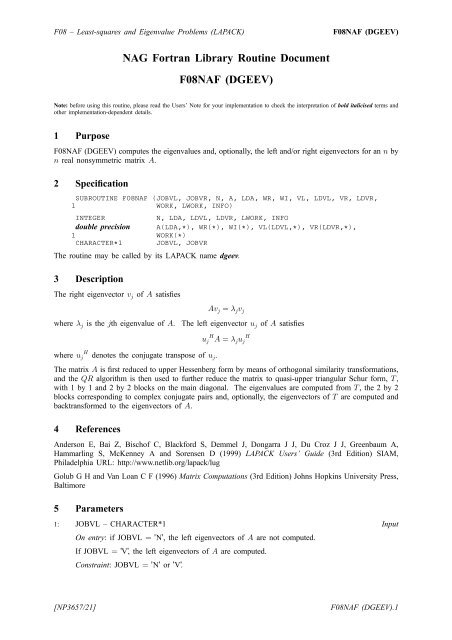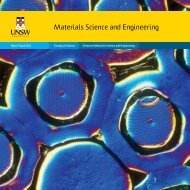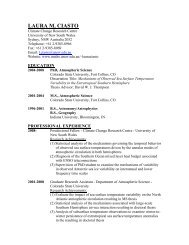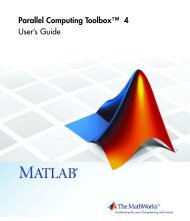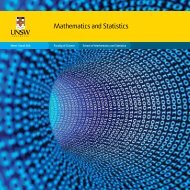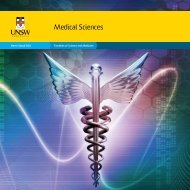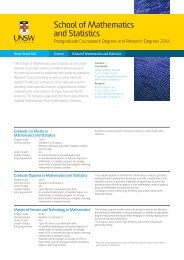NAG Fortran Library Routine Document F08NAF (DGEEV)
NAG Fortran Library Routine Document F08NAF (DGEEV)
NAG Fortran Library Routine Document F08NAF (DGEEV)
You also want an ePaper? Increase the reach of your titles
YUMPU automatically turns print PDFs into web optimized ePapers that Google loves.
F08 – Least-squares and Eigenvalue Problems (LAPACK)<br />
<strong>F08NAF</strong> (<strong>DGEEV</strong>)<br />
<strong>NAG</strong> <strong>Fortran</strong> <strong>Library</strong> <strong>Routine</strong> <strong>Document</strong><br />
<strong>F08NAF</strong> (<strong>DGEEV</strong>)<br />
Note: before using this routine, please read the Users’ Note for your implementation to check the interpretation of bold italicised terms and<br />
other implementation-dependent details.<br />
1 Purpose<br />
<strong>F08NAF</strong> (<strong>DGEEV</strong>) computes the eigenvalues and, optionally, the left and/or right eigenvectors for an n by<br />
n real nonsymmetric matrix A.<br />
2 Specification<br />
SUBROUTINE <strong>F08NAF</strong> (JOBVL, JOBVR, N, A, LDA, WR, WI, VL, LDVL, VR, LDVR,<br />
1 WORK, LWORK, INFO)<br />
INTEGER N, LDA, LDVL, LDVR, LWORK, INFO<br />
double precision A(LDA,*), WR(*), WI(*), VL(LDVL,*), VR(LDVR,*),<br />
1 WORK(*)<br />
CHARACTER*1 JOBVL, JOBVR<br />
The routine may be called by its LAPACK name dgeev.<br />
3 Description<br />
The right eigenvector v j of A satisfies<br />
Av j ¼ j v j<br />
where j is the jth eigenvalue of A.<br />
The left eigenvector u j of A satisfies<br />
u j H A ¼ j u j<br />
H<br />
where u j H denotes the conjugate transpose of u j .<br />
The matrix A is first reduced to upper Hessenberg form by means of orthogonal similarity transformations,<br />
and the QR algorithm is then used to further reduce the matrix to quasi-upper triangular Schur form, T ,<br />
with 1 by 1 and 2 by 2 blocks on the main diagonal. The eigenvalues are computed from T, the 2 by 2<br />
blocks corresponding to complex conjugate pairs and, optionally, the eigenvectors of T are computed and<br />
backtransformed to the eigenvectors of A.<br />
4 References<br />
Anderson E, Bai Z, Bischof C, Blackford S, Demmel J, Dongarra J J, Du Croz J J, Greenbaum A,<br />
Hammarling S, McKenney A and Sorensen D (1999) LAPACK Users’ Guide (3rd Edition) SIAM,<br />
Philadelphia URL: http://www.netlib.org/lapack/lug<br />
Golub G H and Van Loan C F (1996) Matrix Computations (3rd Edition) Johns Hopkins University Press,<br />
Baltimore<br />
5 Parameters<br />
1: JOBVL – CHARACTER*1 Input<br />
On entry: if JOBVL ¼ N , the left eigenvectors of A are not computed.<br />
If JOBVL ¼ V, the left eigenvectors of A are computed.<br />
Constraint: JOBVL ¼ N or V.<br />
[NP3657/21]<br />
<strong>F08NAF</strong> (<strong>DGEEV</strong>).1
<strong>F08NAF</strong> (<strong>DGEEV</strong>)<br />
<strong>NAG</strong> <strong>Fortran</strong> <strong>Library</strong> Manual<br />
2: JOBVR – CHARACTER*1 Input<br />
On entry: if JOBVR ¼ N , the right eigenvectors of A are not computed.<br />
If JOBVR ¼ V, the right eigenvectors of A are computed.<br />
Constraint: JOBVR ¼ N or V.<br />
3: N – INTEGER Input<br />
On entry: n, the order of the matrix A.<br />
Constraint: N 0.<br />
4: AðLDA,Þ – double precision array Input/Output<br />
Note: the second dimension of the array A must be at least maxð1; NÞ.<br />
On entry: the n by n matrix A.<br />
On exit: has been overwritten.<br />
5: LDA – INTEGER Input<br />
On entry: the first dimension of the array A as declared in the (sub)program from which <strong>F08NAF</strong><br />
(<strong>DGEEV</strong>) is called.<br />
Constraint: LDA maxð1; NÞ.<br />
6: WRðÞ – double precision array Output<br />
Note: the dimension of the array WR must be at least maxð1; NÞ.<br />
On exit: see the description of WI below.<br />
7: WIðÞ – double precision array Output<br />
Note: the dimension of the array WI must be at least maxð1; NÞ.<br />
On exit: WR and WI contain the real and imaginary parts, respectively, of the computed<br />
eigenvalues. Complex conjugate pairs of eigenvalues appear consecutively with the eigenvalue<br />
having the positive imaginary part first.<br />
8: VLðLDVL,Þ – double precision array Output<br />
Note: the second dimension of the array VL must be at least maxð1; NÞ.<br />
On exit: if JOBVL ¼ V, the left eigenvectors u j are stored one after another in the columns of VL,<br />
in the same order as their corresponding eigenvalues.<br />
If JOBVL ¼ N , VL is not referenced.<br />
If the jth eigenvalue is real, then u j ¼ VLð:;jÞ, the jth column of VL.<br />
If the jth and ðj þ 1Þst eigenvalues form a complex conjugate pair, then<br />
u j ¼ VLð:;jÞþi VLð:;jþ 1Þ and u jþ1 ¼ VLð:;jÞ i VLð:;jþ 1Þ.<br />
9: LDVL – INTEGER Input<br />
On entry: the first dimension of the array VL as declared in the (sub)program from which <strong>F08NAF</strong><br />
(<strong>DGEEV</strong>) is called.<br />
Constraints:<br />
if JOBVL ¼ V, LDVL maxð1; NÞ;<br />
LDVL 1 otherwise.<br />
<strong>F08NAF</strong> (<strong>DGEEV</strong>).2<br />
[NP3657/21]
F08 – Least-squares and Eigenvalue Problems (LAPACK)<br />
<strong>F08NAF</strong> (<strong>DGEEV</strong>)<br />
10: VRðLDVR,Þ – double precision array Output<br />
Note: the second dimension of the array VR must be at least maxð1; NÞ.<br />
On exit: if JOBVR ¼ V, the right eigenvectors v j are stored one after another in the columns of<br />
VR, in the same order as their corresponding eigenvalues.<br />
If JOBVR ¼ N , VR is not referenced.<br />
If the jth eigenvalue is real, then v j ¼ VRð:;jÞ, the jth column of VR.<br />
If the jth and ðj þ 1Þst eigenvalues form a complex conjugate pair, then<br />
v j ¼ VRð:;jÞþi VRð:;jþ 1Þ and v jþ1 ¼ VRð:;jÞ i VRð:;jþ 1Þ.<br />
11: LDVR – INTEGER Input<br />
On entry: the first dimension of the array VR as declared in the (sub)program from which <strong>F08NAF</strong><br />
(<strong>DGEEV</strong>) is called.<br />
Constraints:<br />
if JOBVR ¼ V, LDVR maxð1; NÞ;<br />
LDVR 1 otherwise.<br />
12: WORKðÞ – double precision array Workspace<br />
Note: the dimension of the array WORK must be at least maxð1; LWORKÞ.<br />
On exit: ifINFO ¼ 0, WORKðÞreturns 1 the optimal LWORK.<br />
13: LWORK – INTEGER Input<br />
On entry: the dimension of the array WORK as declared in the (sub)program from which <strong>F08NAF</strong><br />
(<strong>DGEEV</strong>) is called.<br />
For good performance, LWORK must generally be larger than the minimum, say, 4 N þ nb N,<br />
where nb is the optimal block size of F08NEF (DGEHRD).<br />
If LWORK ¼ 1, a workspace query is assumed; the routine only calculates the optimal size of the<br />
WORK array, returns this value as the first entry of the WORK array, and no error message related<br />
to LWORK is issued.<br />
Constraints:<br />
if JOBVL ¼ V or JOBVR ¼ V, LWORK 4 N;<br />
LWORK maxð1; 3 NÞ otherwise.<br />
14: INFO – INTEGER Output<br />
On exit: INFO ¼ 0 unless the routine detects an error (see Section 6).<br />
6 Error Indicators and Warnings<br />
Errors or warnings detected by the routine:<br />
INFO < 0<br />
If INFO ¼<br />
i, the ith argument had an illegal value.<br />
INFO > 0<br />
If INFO ¼ i, the QR algorithm failed to compute all the eigenvalues, and no eigenvectors have<br />
been computed; elements i þ 1 :Nof WR and WI contain eigenvalues which have converged.<br />
[NP3657/21]<br />
<strong>F08NAF</strong> (<strong>DGEEV</strong>).3
<strong>F08NAF</strong> (<strong>DGEEV</strong>)<br />
<strong>NAG</strong> <strong>Fortran</strong> <strong>Library</strong> Manual<br />
7 Accuracy<br />
The computed eigenvalues and eigenvectors are exact for a nearby matrix<br />
and is the machine precision.<br />
8 Further Comments<br />
kEk 2<br />
¼ OðÞA<br />
k k 2<br />
,<br />
ðA þ EÞ, where<br />
See Section 4.8 of Anderson et al. (1999) for further details.<br />
Each eigenvector is normalized to have Euclidean norm equal to unity and the element of largest absolute<br />
value real and positive.<br />
The total number of floating-point operations is proportional to n 3 .<br />
The complex analogue of this routine is F08NNF (ZGEEV).<br />
9 Example<br />
To find all the eigenvalues and right eigenvectors of the matrix<br />
0<br />
1<br />
0:35 0:45 0:14 0:17<br />
0:09 0:07 0:54 0:35<br />
A ¼ B<br />
C<br />
@ 0:44 0:33 0:03 0:17 A .<br />
0:25 0:32 0:13 0:11<br />
Note that the block size (NB) of 64 assumed in this example is not realistic for such a small problem, but<br />
should be suitable for large problems.<br />
9.1 Program Text<br />
Note: the listing of the example program presented below uses bold italicised terms to denote precision-dependent details. Please read the<br />
Users’ Note for your implementation to check the interpretation of these terms. As explained in the Essential Introduction to this manual,<br />
the results produced may not be identical for all implementations.<br />
* <strong>F08NAF</strong> Example Program Text<br />
* Mark 21. <strong>NAG</strong> Copyright 2004<br />
* .. Parameters ..<br />
INTEGER NIN, NOUT<br />
PARAMETER<br />
(NIN=5,NOUT=6)<br />
INTEGER NB, NMAX<br />
PARAMETER<br />
(NB=64,NMAX=10)<br />
INTEGER LDA, LDVR, LWORK<br />
PARAMETER<br />
(LDA=NMAX,LDVR=NMAX,LWORK=(2+NB)*NMAX)<br />
* .. Local Scalars ..<br />
COMPLEX *16 EIG<br />
INTEGER I, INFO, J, LWKOPT, N<br />
* .. Local Arrays ..<br />
DOUBLE PRECISION A(LDA,NMAX), DUMMY(1,1), VR(LDVR,NMAX), WI(NMAX),<br />
+ WORK(LWORK), WR(NMAX)<br />
* .. External Subroutines ..<br />
EXTERNAL<br />
<strong>DGEEV</strong><br />
* .. Intrinsic Functions ..<br />
INTRINSIC<br />
DCMPLX<br />
* .. Executable Statements ..<br />
WRITE (NOUT,*) ’<strong>F08NAF</strong> Example Program Results’<br />
* Skip heading in data file<br />
READ (NIN,*)<br />
READ (NIN,*) N<br />
IF (N.LE.NMAX) THEN<br />
*<br />
* Read the matrix A from data file<br />
*<br />
READ (NIN,*) ((A(I,J),J=1,N),I=1,N)<br />
*<br />
* Compute the eigenvalues and right eigenvectors of A<br />
*<br />
CALL <strong>DGEEV</strong>(’No left vectors’,’Vectors (right)’,N,A,LDA,WR,WI,<br />
<strong>F08NAF</strong> (<strong>DGEEV</strong>).4<br />
[NP3657/21]
F08 – Least-squares and Eigenvalue Problems (LAPACK)<br />
<strong>F08NAF</strong> (<strong>DGEEV</strong>)<br />
+ DUMMY,1,VR,LDVR,WORK,LWORK,INFO)<br />
LWKOPT = WORK(1)<br />
*<br />
IF (INFO.EQ.0) THEN<br />
*<br />
* Print solution<br />
*<br />
DO 20 J = 1, N<br />
WRITE (NOUT,*)<br />
IF (WI(J).EQ.0.0D0) THEN<br />
WRITE (NOUT,99999) ’Eigenvalue(’, J, ’) = ’, WR(J)<br />
ELSE<br />
EIG = DCMPLX(WR(J),WI(J))<br />
WRITE (NOUT,99998) ’Eigenvalue(’, J, ’) = ’, EIG<br />
END IF<br />
WRITE (NOUT,*)<br />
WRITE (NOUT,99997) ’Eigenvector(’, J, ’)’<br />
IF (WI(J).EQ.0.0D0) THEN<br />
WRITE (NOUT,99996) (VR(I,J),I=1,N)<br />
ELSE IF (WI(J).GT.0.0D0) THEN<br />
WRITE (NOUT,99995) (VR(I,J),VR(I,J+1),I=1,N)<br />
ELSE<br />
WRITE (NOUT,99995) (VR(I,J-1),-VR(I,J),I=1,N)<br />
END IF<br />
20 CONTINUE<br />
ELSE<br />
WRITE (NOUT,*)<br />
WRITE (NOUT,99994) ’Failure in <strong>DGEEV</strong>. INFO = ’, INFO<br />
END IF<br />
*<br />
* Print workspace information<br />
*<br />
IF (LWORK.LT.LWKOPT) THEN<br />
WRITE (NOUT,*)<br />
WRITE (NOUT,99993) ’Optimum workspace required = ’, LWKOPT,<br />
+ ’Workspace provided = ’, LWORK<br />
END IF<br />
ELSE<br />
WRITE (NOUT,*)<br />
WRITE (NOUT,*) ’NMAX too small’<br />
END IF<br />
STOP<br />
*<br />
99999 FORMAT (1X,A,I2,A,1P,E11.4)<br />
99998 FORMAT (1X,A,I2,A,’(’,1P,E11.4,’,’,1P,E11.4,’)’)<br />
99997 FORMAT (1X,A,I2,A)<br />
99996 FORMAT (1X,1P,E11.4)<br />
99995 FORMAT (1X,’(’,1P,E11.4,’,’,1P,E11.4,’)’)<br />
99994 FORMAT (1X,A,I4)<br />
99993 FORMAT (1X,A,I5,/1X,A,I5)<br />
END<br />
9.2 Program Data<br />
<strong>F08NAF</strong> Example Program Data<br />
4 :Value of N<br />
0.35 0.45 -0.14 -0.17<br />
0.09 0.07 -0.54 0.35<br />
-0.44 -0.33 -0.03 0.17<br />
0.25 -0.32 -0.13 0.11 :End of matrix A<br />
9.3 Program Results<br />
<strong>F08NAF</strong> Example Program Results<br />
Eigenvalue( 1) = 7.9948E-01<br />
Eigenvector( 1)<br />
[NP3657/21]<br />
<strong>F08NAF</strong> (<strong>DGEEV</strong>).5
<strong>F08NAF</strong> (<strong>DGEEV</strong>)<br />
<strong>NAG</strong> <strong>Fortran</strong> <strong>Library</strong> Manual<br />
-6.5509E-01<br />
-5.2363E-01<br />
5.3622E-01<br />
-9.5607E-02<br />
Eigenvalue( 2) = (-9.9412E-02, 4.0079E-01)<br />
Eigenvector( 2)<br />
(-1.9330E-01, 2.5463E-01)<br />
( 2.5186E-01,-5.2240E-01)<br />
( 9.7182E-02,-3.0838E-01)<br />
( 6.7595E-01, 0.0000E+00)<br />
Eigenvalue( 3) = (-9.9412E-02,-4.0079E-01)<br />
Eigenvector( 3)<br />
(-1.9330E-01,-2.5463E-01)<br />
( 2.5186E-01, 5.2240E-01)<br />
( 9.7182E-02, 3.0838E-01)<br />
( 6.7595E-01, 0.0000E+00)<br />
Eigenvalue( 4) = -1.0066E-01<br />
Eigenvector( 4)<br />
1.2533E-01<br />
3.3202E-01<br />
5.9384E-01<br />
7.2209E-01<br />
<strong>F08NAF</strong> (<strong>DGEEV</strong>).6 (last)<br />
[NP3657/21]


